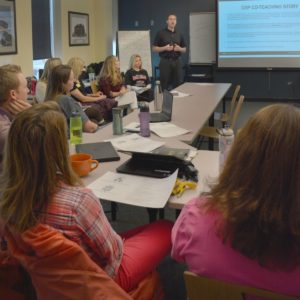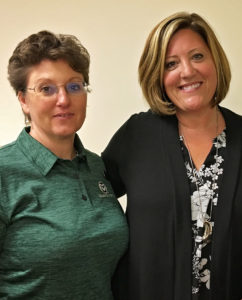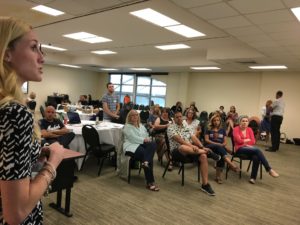Colorado, like the rest of the nation, is facing a shortage of school teachers. Nationally, fewer people are entering educator preparation programs; the number of those who complete their program are even lower. In Colorado, the Department of Higher Education reports a downward trend in the number of people completing educator prep programs – nearly 800 fewer in 2016 than in 2011. Additionally, nearly 25 percent of teachers leave the profession within their first four years, and more teachers are preparing to retire.
According to data gathered by CDHE and the Colorado Department of Education, the teacher shortage in rural areas – which includes nearly every part of the state except the Front Range-Interstate 25 corridor – has reached crisis levels.
 To address this crisis, the Colorado legislature passed — and in May Gov. John Hickenlooper signed into law — a bill geared toward creating a strategic plan to address the state’s teacher shortage. The first step in implementing the Educator Shortage Action Plan was a statewide series of town halls.
To address this crisis, the Colorado legislature passed — and in May Gov. John Hickenlooper signed into law — a bill geared toward creating a strategic plan to address the state’s teacher shortage. The first step in implementing the Educator Shortage Action Plan was a statewide series of town halls.
The Fort Collins stop on the tour by Robert Mitchell, CDHE director of educator preparation, and Mary Bivens, CDE director of educator development, was held in late July on the Colorado State University campus, sponsored by CSU’s Center for Educator Preparation. Participants included current and retired teachers, parents, higher education faculty members, current and former members of local Boards of Education, and more.
Two main points were made during the presentation:
- Colorado has pressing needs across the state in nearly every area – particularly in our remote rural locations, and
- Rural districts are significantly impacted today, and our urban/suburban districts will be impacted in the very near future.
“We can’t keep doing what we’re doing,” said Mitchell. “It’s not sustainable.”
Causes of the shortage
Both CDE and CDHE have been researching the causes of the shortage.
“We know the reasons people aren’t entering – and why they’re not staying – in the profession,” said Mitchell. “The external perception of what teachers do and how they work, the limited salary offered to new educators entering the profession, and the increasing costs of a college degree and the required return-on-investment.”
Retaining current teachers is another challenge. According to Mitchell, those who leave the profession most often cite building climate and leadership, poor pay, and large workloads as their primary reasons for changing careers.
“A lot of the research talks about early teachers not feeling prepared, not feeling capable, not feeling success those first couple of years,” said Bivens.
Preparation is where CSU can contribute to a solution to the crisis. The Center for Educator Preparation ensures teacher candidates are prepared, mentored, and supported throughout the four phases of the program, ensuring they have the skills and strategies needed for longevity in the profession.
“We consider professionally prepared educators to be competent in their knowledge, skills, and dispositions,” said Heidi Frederiksen, co-chair of CEP.

Preparation is critical
In today’s climate, said people aren’t becoming teachers just because they aren’t sure what else to pursue.
“When they come to us,” Frederiksen said, “we know they have a passion for teaching.”
It’s not enough to be passionate about teaching, however. CEP knows new teachers need to begin their careers feeling confident and prepared.
“Successful teachers are well-educated and prepared – they don’t just come in with content knowledge,” she added.
At CSU, undergraduate students interested in teacher licensure earn bachelor degrees in a content area based on grade levels and/or subjects they have an interest in teaching, such as history, English, biology, etc.
Currently, CEP offers 17 endorsement areas, covering everything from Early Childhood Education (pre-kindergarten through grade three) to art, foreign language, technology and music for kindergarten through grade 12, to business, science, math, agricultural education and more for grades 7 through 12. CEP works alongside instructors and advisers in the various content areas across the University to ensure faculty and students feel supported and connected to the Center.
“We’re very intentional about reaching out to them,” said Ann Sebald, co-chair of CEP. “We have monthly meetings with the methods instructors in these content areas to discuss teacher preparation, what’s happening throughout the state and nationally around teacher licensure, and the nuts and bolts of the program.”
Alongside their content area coursework, licensure students take teaching pedagogy through the Center for Educator Preparation that support content knowledge.
Pedagogy: the craft of teaching
“We define ‘pedagogy’ as the professionalism of the craft of teaching – the language of teaching,” Sebald explained. “It’s essentially the art and science of teaching, of learning how to communicate content knowledge,” added Frederiksen.
Both Sebald and Frederiksen place emphasis on strong pedagogical training and understanding as a key to longevity in the profession of teaching. Because teacher candidates are gaining in-depth content knowledge, it can be tempting to assume they are able to translate that knowledge into teaching. However, there can be a disconnect between knowing information and being able to communicate it in a way that allows a student to learn effectively.
“Research is coming out comparing those prepared through an alternative path and those who go through a higher education, more professional preparation program,” Sebald explained. “Those who complete professional preparation programs have better longevity in the field.”
Practical experience from the beginning
Throughout CEP’s licensure program, which consists of four phases, teacher candidates spend a varying amount of time in local classrooms, with CEP faculty observing their field experience, practicum, and student teaching progress. Thanks to close partnerships with local school districts, teacher candidates finish the program with at least 800 hours of practical, hands-on experience in schools.
 “The Professional Development School model means we partner with local school districts to allow teacher candidates the opportunity to gain experience in real schools, with real students, from the very beginning of the program,” explained Sebald.
“The Professional Development School model means we partner with local school districts to allow teacher candidates the opportunity to gain experience in real schools, with real students, from the very beginning of the program,” explained Sebald.
In addition to leading the way locally by integrating co-teaching throughout the preparation program, CEP faculty is involved in the national conversation on co-teaching, helping to research, then shape, how co-teaching is incorporated into teacher preparation. The hope is that co-teaching can help extend the number of years a new teacher – and, for that matter, a cooperating teacher – spends in the profession.
“We’ve seen our teacher candidates benefit from co-teaching,” said Frederiksen. “We’ve also seen cooperating teachers’ passion for their job be reignited through their mentorship of teacher candidates. We hope that helps keep them in the classrooms, because we know kids benefit from experienced teachers.”
Mentoring and support
According to comments at the Educator Shortage Action Plan town hall, one way to help early career teachers feel prepared, capable, or successful is to improve mentoring opportunities in school districts.
While induction and mentoring are already required programs at the district level, they are often unfunded mandates; schools around the state rarely have the resources needed to support these programs in a robust and effective way.
During the CSU teacher preparation program, CEP faculty and staff offer strong mentoring and support to teacher candidates. In continuing to build strong partnerships with local school districts, CEP offers ways in which they can facilitate this effort with the schools. These mentoring and support efforts benefit not only early-career teachers, but cooperating teachers who take on student teachers, and those seeking professional development opportunities.
“Often, my conversation with our schools is, ‘You don’t have many resources – how can we help?’” said Frederiksen. “We’re being much more intentional about being integrated into the schools and helping them where we can.”
The Center for Educator Preparation is part of the School of Education, in CSU’s College of Health and Human Sciences.